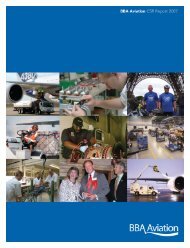Annual Report 2010 in PDF - BBA Aviation
Annual Report 2010 in PDF - BBA Aviation
Annual Report 2010 in PDF - BBA Aviation
You also want an ePaper? Increase the reach of your titles
YUMPU automatically turns print PDFs into web optimized ePapers that Google loves.
Guidance on Audit Committees. The Audit Committee has conf rmed<br />
that dur<strong>in</strong>g the year it had formal and transparent arrangements for<br />
consider<strong>in</strong>g fnancial report<strong>in</strong>g and <strong>in</strong>ternal control pr<strong>in</strong>ciples and<br />
ma<strong>in</strong>ta<strong>in</strong><strong>in</strong>g an appropriate relationship with the Company’s auditors.<br />
One of the safeguards to ensure auditor objectivity and<br />
<strong>in</strong>dependence is the Group’s policy on the provision of non-audit<br />
services by its external auditors. The Committee is aware that the<br />
Account<strong>in</strong>g Practices Board has issued further guidance <strong>in</strong> this area to<br />
take efect from 30 April 2011 and the Company’s policy will be<br />
reviewed aga<strong>in</strong> <strong>in</strong> the light of the new guidance. At present the policy<br />
prohibits the Group’s external auditors from carry<strong>in</strong>g out certa<strong>in</strong><br />
additional services for the Group <strong>in</strong>clud<strong>in</strong>g book-keep<strong>in</strong>g, <strong>in</strong>ternal<br />
audit, valuations, actuarial services and fnancial systems design and<br />
implementation. Services which the external auditors may be<br />
permitted to carry out under the current policy <strong>in</strong>clude assurance<br />
services such as report<strong>in</strong>g accountant work and tax services. The<br />
Committee is satisfed that the majority of the tax services supplied by<br />
Deloitte LLP are compliance-related and represent a small proportion<br />
of Group tax fees.<br />
The Company’s policy is not to use the external auditors for<br />
acquisition and due diligence work. However, where the Group<br />
considers it appropriate or where conficts arise, suppliers other than<br />
the preferred supplier may be asked to tender. This would only <strong>in</strong>clude<br />
the external auditors <strong>in</strong> unusual and exceptional circumstances.<br />
Non-audit fees paid or due to the external auditors are regularly<br />
reviewed by the Committee and those paid <strong>in</strong> <strong>2010</strong> are set out <strong>in</strong><br />
note 2 to the Consolidated F<strong>in</strong>ancial Statements.<br />
If fees for non-audit projects with<strong>in</strong> the scope of permitted<br />
services are expected to exceed £250,000 <strong>in</strong> a particular year, then the<br />
Committee Chairman is required to pre-approve each project. In any<br />
event, specifc project approval is required by the Committee<br />
Chairman for any such project where estimated fees exceed £100,000.<br />
Deloitte LLP have confrmed that all non-audit services they<br />
performed dur<strong>in</strong>g the year were permitted by APB Ethical Standards<br />
and do not impair their <strong>in</strong>dependence or objectivity. On the basis of<br />
their own review of the services performed, the requirement of preapproval<br />
and the auditors’ confrmation, the Committee is satisfed<br />
that the non-audit services currently provided by Deloitte LLP do not<br />
impair their <strong>in</strong>dependence and objectivity.<br />
b. Systems of Internal Control<br />
Overall responsibility for the Group’s system of <strong>in</strong>ternal control and for<br />
review<strong>in</strong>g its efectiveness rests with the directors. Management is<br />
accountable to the directors for monitor<strong>in</strong>g this system and for<br />
provid<strong>in</strong>g assurance to the directors that it has done so. The system of<br />
<strong>in</strong>ternal control is essentially an ongo<strong>in</strong>g process embedded <strong>in</strong> the<br />
Group’s bus<strong>in</strong>esses for identify<strong>in</strong>g, evaluat<strong>in</strong>g and manag<strong>in</strong>g the<br />
signifcant risks faced by the Group, <strong>in</strong>clud<strong>in</strong>g social, environmental<br />
and ethical risks. The Group considers that it has adequate <strong>in</strong>formation<br />
to identify and assess signifcant risks and opportunities af ect<strong>in</strong>g its<br />
long and short-term value.<br />
This process has been <strong>in</strong> place for the year ended 31 December<br />
<strong>2010</strong> and up to 1 March 2011 and the directors can therefore conf rm<br />
that they have reviewed the efectiveness <strong>in</strong> accordance with the<br />
<strong>in</strong>ternal control requirements of the Code throughout that period.<br />
The Group’s <strong>in</strong>ternal system of control is reviewed annually by<br />
the directors and accords with the guidance issued by the F<strong>in</strong>ancial<br />
<strong>Report</strong><strong>in</strong>g Council <strong>in</strong> October 2005: “Internal Control: Revised<br />
Guidance for Directors on the Code”. The system is designed to<br />
manage rather than elim<strong>in</strong>ate the risk of failure to achieve bus<strong>in</strong>ess<br />
objectives. It can provide reasonable but not absolute assurance<br />
aga<strong>in</strong>st material misstatement or loss, to the extent that is appropriate,<br />
tak<strong>in</strong>g account of costs and benefts.<br />
The ma<strong>in</strong> features of the Group’s <strong>in</strong>ternal control and risk<br />
management systems are listed below.<br />
1. The risks identifed through a detailed written self-assessment<br />
process carried out by division and by function are recorded on a<br />
risk register together with the mitigations <strong>in</strong> place. This covers a<br />
range of diferent types of risks, such as:<br />
– bus<strong>in</strong>ess;<br />
– f nancial;<br />
– compliance;<br />
– operational; and<br />
– other categories of risks <strong>in</strong>clud<strong>in</strong>g health,<br />
safety and environmental risks.<br />
In addition the risks identifed are plotted on risk maps and both<br />
the self-assessments and the risk maps are reviewed by the <strong>in</strong>ternal<br />
audit department and by senior management at quarterly<br />
operat<strong>in</strong>g review meet<strong>in</strong>gs held with each bus<strong>in</strong>ess. The outcome<br />
from these reviews is then discussed twice each year at meet<strong>in</strong>gs of<br />
the Executive Management Committee, with the results be<strong>in</strong>g<br />
presented to the Audit Committee, which <strong>in</strong> turn reviews the<br />
efectiveness of the Group’s system of <strong>in</strong>ternal control on behalf of<br />
the Board. The Audit Committee receives a report at least twice a<br />
year from the Group F<strong>in</strong>ance Director detail<strong>in</strong>g the risks and the<br />
work undertaken <strong>in</strong> manag<strong>in</strong>g the risks faced by the Group. Based<br />
on this <strong>in</strong>formation the Board reviews the risks and conf rms they<br />
are satisfed that the risks are appropriately mitigated. If this is not<br />
the case they request that management take further action.<br />
The process to identify risks and their mitigation has been<br />
supplemented by externally facilitated risk workshops carried out with<strong>in</strong><br />
a number of operat<strong>in</strong>g units and with the Executive Management<br />
Committee and other members of senior management.<br />
2. An organisational structure is <strong>in</strong> place at both head of ce and<br />
divisional level which clearly defnes responsibilities for operational,<br />
account<strong>in</strong>g, taxation, treasury, legal, company secretarial and<br />
<strong>in</strong>surance functions.<br />
3. An <strong>in</strong>ternal audit function undertakes a programme of risk-based<br />
reviews of controls and bus<strong>in</strong>ess processes. The role of <strong>in</strong>ternal<br />
audit is defned <strong>in</strong> a Group Internal Audit Charter and this <strong>in</strong>cludes<br />
its terms of reference, the standards which it adheres to, the scope<br />
and coverage of its work and its report<strong>in</strong>g processes. The Audit<br />
Committee receives a report from <strong>in</strong>ternal audit at each meet<strong>in</strong>g<br />
which <strong>in</strong>cludes op<strong>in</strong>ions on the adequacy and ef ectiveness<br />
of controls by site, a summary of key issues, work schedules<br />
and details of any action required. In accordance with the Code,<br />
the Audit Committee regularly monitors and reviews the<br />
efectiveness of <strong>in</strong>ternal audit us<strong>in</strong>g outside specialists as well as<br />
self-assessment techniques.<br />
4. A Group F<strong>in</strong>ance Manual details account<strong>in</strong>g policies and f nancial<br />
controls applicable to all report<strong>in</strong>g units. The Group account<strong>in</strong>g<br />
policies are aligned with the latest International F<strong>in</strong>ancial <strong>Report</strong><strong>in</strong>g<br />
Standards. Compliance with these policies is reviewed as part of the<br />
<strong>in</strong>ternal audit process.<br />
Directors’ <strong>Report</strong> — 73




